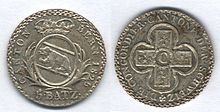Batzen

Vaud
, 1812
Freiburg
(Freyburg): 1 Batzen 1830The batzen is an historical Swiss, south German and Austrian coin. It was first produced in Bern, Switzerland, from 1492 and continued in use there until the mid-19th century.
Name
Bernese chronicler
Swiss canton, which was embossed on the reverse of the coin. The word probably goes back to Upper German (particularly Bavarian) batzen ("stick together") or Batzen ("lump, thick piece"), since it referred to a Dickpfennig ("fat pfennig").[1]
History
A double
The Batzen was originally minted in
Old Confederation and some southern German states soon followed Bern's example. Zürich minted 16 Batzen to the Gulden from 1500 onwards. In 1564, a Thaler was worth 16 Constance Batzen.[4] Around 1600, 1 Bocksthaler (Schaffhausen Thaler) was worth 17 Batzen or 68 Kreuzer, so 1 Batzen = 1⁄17 Thaler = 4 Kreuzer.[5] In the early 18th century the Hohlbatzen ("hollow Batzen") was worth five Kreuzer (1/12 Reichsgulden), the regular Batzen four Kreuzer, the Basel and Zürich Batzen were valued at 1⁄18 Gulden, the St. Gallen Batzen at 1⁄17 Gulden. In the second half of the 18th century, 1 Reichsbatzen was worth 16 Pfennigs, 1 Zürich Batzen was 15 Pfennigs, 1 Bernese or 1 Chur Batzen was 14 Pfennigs.[6]
The Batzen became a widespread intermediate currency between the numerous large and small silver coins circulating in Europe. Since some of the South German Batzen were of very different quality, the
Imperial Minting Ordinance of 1559. However it was still, for example in Nuremberg, in 1564[7]
in use as a currency designation. In Switzerland, on the other hand, the Batzen went unchallenged.
In the case of some so-called
Kipper and Wipper period, for example in Thuringia inter alia in the mints of Gotha (1621–1623) and Weimar (1619–1622), other Kipper coins worth three and six Batzen were minted (the Dreibätzner and Sechsbätzner). The coins could not be objected to, because they were state coins
, not Thaler coins or divisions of them, which had to conform to imperial coinage regulations.
Even after the
Mark
in 1871. As late as 1873, the increase in the price of beer by the Frankfurt breweries from 4 to 4½ Kreuzer triggered the Frankfurt beer riot, which began with the demand "I want Batzen beer" (Mir wolle Batzebier) and led to serious social unrest.

When a Swiss single currency was introduced for the first time in 1798–1803 by the
Florin-Livre system. The era of the Batzen ended in 1850 with the introduction of the new Swiss franc
as the single Swiss currency. An old franc did not correspond to a new franc. Seven Batzen could be exchanged for a new franc in 1850. Meanwhile, the Batzen became a colloquial term for the 10 Rappen (10 cent) coin.
References
Wikimedia Commons has media related to Batzen.
- Etymologisches Wörterbuch der deutschen Sprache. 25th edition, edited by Elmar Seebold. De Gruyter, Berlin/Boston 2011, p. 96.
- ^ Anne-Marie Dubler: Batzen in German, French and Italian in the online Historical Dictionary of Switzerland.
- ^ Albert Escher: Schweizerische Münz-und Geldgeschichte. Volume I. Bern, 1881, p. 149.
- ^ Swiss Idiotikon, Volume II, col. 228 (digitalised) and Volume IV, col. 1964 ff. (digitalised).
- ^ Karl Christoph Schmieder: Handwörterbuch der gesammten Münzkunde. Waisenhaus, Halle/Berlin 1811, p. 61; Helmut Kahnt: Das große Münzlexikon von A bis Z. Battenberg Gietl, Regenstauf 2005, p. 43.
- ^ Swiss Idiotikon, Volume IV, col. 1964 f. (digitalised).
- ^ Doris Wolfangel: Dr. Melchior Ayrer (1520–1579). Medical dissertation, Würzburg 1957, pp. 19 ff.

